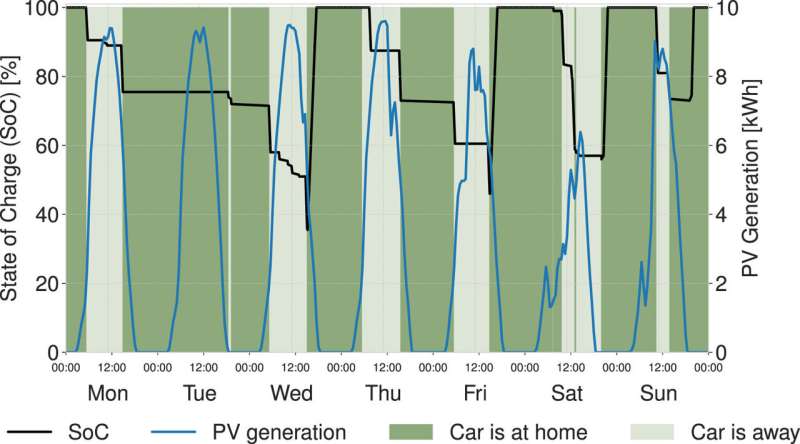Charging electric vehicles with photovoltaics at home

An electric car that runs on PV power sounds appealing. But is it really possible to enjoy flexibility with a vehicle charged through a home photovoltaic system? An ETH research team has reached some surprising conclusions.
The area of photovoltaics (PV) is rapidly increasing in popularity, and in Switzerland it already covers 5 percent of the country's electricity consumption. Electromobility is also seeing strong growth—with currently 70,000 pure electric vehicles on Swiss roads, plus 200,000 hybrids. Martin Raubal, Professor of Geoinformation Engineering at ETH Zurich, welcomes the development: "The mobility sector is responsible for about a third of greenhouse gases in Switzerland. Electromobility is one way to reduce CO2 emissions from transport."
Solar power and e-mobility are a perfect match
A research team led by Raubal has now brought the growth of photovoltaics and electromobility together in a hypothetical approach. The scientists wanted to know the extent to which electric car owners are able to charge their vehicles with power from their own photovoltaics system without restricting their car use any more than with conventional mains charging. Many people are skeptical about the concept of charging with PV power: "How can I use my electric car if it has to be charged during the day while the sun is shining?" is a common response.
The study by the ETH researchers goes a long way to countering this skepticism: "Our results show that owners of electric vehicles can use their cars with no particular restrictions, charging them to a large extent with their own photovoltaic power, even without intermediate storage," says Henry Martin summarizing the study's main result. Martin is a doctoral student at the Institute of Cartography and Geoinformation at ETH Zurich and conducts research at the Institute of Advanced Research in Artificial Intelligence (IARAI) in Vienna. The study by the ETH scientists has just been published in the journal Renewable & Sustainable Energy Reviews.
Real user data, virtual PV generation
The study focused on 78 electric mobility users, who generally lived in a single-family home and often used their vehicles during the day. Their user behavior was recorded meticulously for ten months, enabling the ETH researchers to know when the electric cars were driven, when they were stationary and when they were being charged. The user data came from the "SBB Green Class" project, in which private individuals were able to purchase a mobility package consisting of a GA travelcard and an electric car, including a private charging station.
The owners mostly charged their electric cars at their home charging station with mains electricity. Would they have been able to use their cars just as flexibly if they had charged them with power from their own PV system? In order to answer this question, Martin's fellow researcher René Buffat equipped the homes of the 78 electric vehicle owners with a hypothetical PV system: he identified the houses via their addresses, reconstructed the available roof area using geospatial data and covered it virtually with solar panels. Using historical weather data with a 30-minute resolution, Buffat calculated the potential solar power yield, taking into account factors such as shade from neighboring buildings and trees.
High level of private consumption thanks to intelligent control
Based on this model calculation, the ETH researchers were able to determine how much PV power was available to each electric car owner at any given time to charge their vehicle. They made the assumption that the power would be used primarily to charge the electric vehicle. The maximum charging power in the model was 11 kilowatts (kW). Depending on the house, the PV systems had a peak power of 5 to 25 kW, which was usually sufficient to charge the car at full power in sunshine.
For four different charging strategies, the researchers calculated the proportion of household PV power required to charge the electric cars without any change in user mobility behavior. In the first case, they were charged at the same time as previously with mains electricity, but now with PV power, if available. The result was sobering: on average, only 15 percent of annual electricity requirements was met by PV power (the rest by mains electricity).
The second charging strategy, where a simple intelligent control (smart charging) ensured that the battery was charged whenever household PV power was available, had a different result. In this case, more than half (56 percent) of electricity requirements was met with household PV power, without the need for temporary storage. "We were surprised by the high proportion," says Martin. "Smart charging can significantly increase the household consumption of photovoltaic power—and the vehicle can be used just as flexibly as if it were charged with mains electricity."
Algorithms for smart charging
If the potential of intelligent control is consistently exploited (the third charging strategy), electric vehicles can even be charged with household PV power up to 90 percent of the time. If the PV power is buffered in a storage unit (fourth charging strategy), the vehicles can be driven almost exclusively using solar energy. The ETH researchers are ambivalent about intermediate storage, however. Although household consumption of green PV power can be increased slightly, the sustainability balance of the charging system as a whole is affected by the fact that the production of electricity storage units causes relevant quantities of CO2.
"Our case study demonstrates the potential of smart charging for a decentralized and grid-friendly supply of renewable energy that has been exploited very little so far," says Raubal. His research group is currently working on developing machine learning strategies with a view to predicting PV yield and user behavior as accurately as possible. These strategies form the basis of the development of smart-charging algorithms, which it is hoped will soon be used as standard in charging stations for electric vehicles.
More information: H. Martin et al, Using rooftop photovoltaic generation to cover individual electric vehicle demand—A detailed case study, Renewable and Sustainable Energy Reviews (2022). DOI: 10.1016/j.rser.2021.111969


















